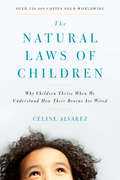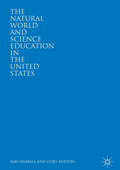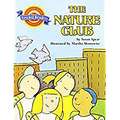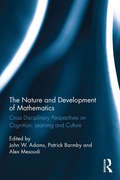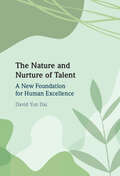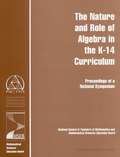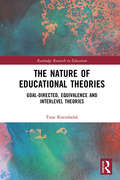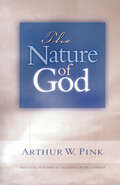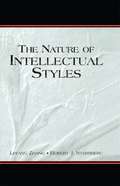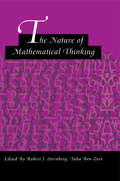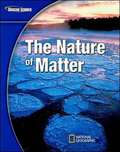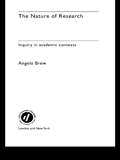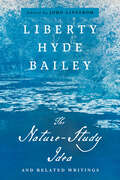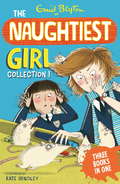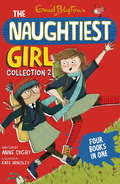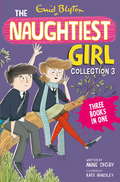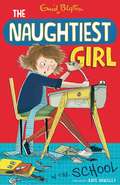- Table View
- List View
The Natural History of the Bible: An Environmental Exploration of the Hebrew Scriptures
by Daniel HillelTraversing river valleys, steppes, deserts, rain-fed forests, farmlands, and seacoasts, the early Israelites experienced all the contrasting ecological domains of the ancient Near East. As they grew from a nomadic clan to become a nation-state in Canaan, they interacted with indigenous societies of the region, absorbed selective elements of their cultures, and integrated them into a radically new culture of their own. Daniel Hillel reveals the interplay between the culture of the Israelites and the environments within which it evolved. More than just affecting their material existence, the region's ecology influenced their views of creation and the creator, their conception of humanity's role on Earth, their own distinctive identity and destiny, and their ethics.In The Natural History of the Bible, Hillel shows how the eclectic experiences of the Israelites shaped their perception of the overarching unity governing nature's varied manifestations. Where other societies idolized disparate and capricious forces of nature, the Israelites discerned essential harmony and higher moral purpose. Inspired by visionary prophets, they looked to a singular, omnipresent, omnipotent force of nature mandating justice and compassion in human affairs. Monotheism was promoted as state policy and centralized in the Temple of Jerusalem. After it was destroyed and the people were exiled, a collection of scrolls distilling the nation's memories and spiritual quest served as the focus of faith in its stead.A prominent environmental scientist who surveyed Israel's land and water resources and has worked on agricultural development projects throughout the region, Daniel Hillel is a uniquely qualified expert on the natural history of the lands of the Bible. Combining his scientific work with a passionate, life-long study of the Bible, Hillel offers new perspectives on biblical views of the environment and the origin of ethical monotheism as an outgrowth of the Israelites' internalized experiences.
The Natural Laws of Children: Why Children Thrive When We Understand How Their Brains Are Wired
by Celine AlvarezA powerful, neuroscience-based approach to revolutionize early childhood learning through natural creativity, strong human connections, spontaneous free play, and more.All children are born wired to learn and to love. As young children explore the world and interact with others, their brains can naturally develop in incredible ways. And yet, despite our best intentions, early education often fails to fully encourage this natural learning and empathy. The Natural Laws of Children draws on current research in childhood development to share powerful insights on how to enhance learning for all kids, regardless of income or access to resources. This book tells the story of Céline Alvarez’s pioneering work in early childhood education. Over three years in a low-income school, Alvarez’s students achieved exceptional results in math and reading, as well as outstanding social and emotional skills. The Natural Laws of Children shares, in a clear and accessible way, the main scientific principles that underpin human learning to revolutionize early childhood education by supporting strong human connections, spontaneous free play, and more.
The Natural World and Science Education in the United States
by Ajay Sharma Cory BuxtonThis book focuses on the representation of nature in science education in schools in the United States. Given the importance of our relationship with the nonhuman world for the fate of our planet, this work gives special attention to the representation, instruction, and understanding of the relationship between the social and the natural world. It also proposes an alternative, sustainability science-based conceptual framework for ecology and environmental science topics in science education, which is compatible with the current social-ecological understanding of life in the Anthropocene epoch.
The Nature Club: Leveled Readers
by Susan SpearHow can you have a nature club in the city? As you read the story, stop from time to time and summarize what has happened so far.
The Nature and Development of Mathematics: Cross Disciplinary Perspectives on Cognition, Learning and Culture
by John Adams Alex Mesoudi Patrick BarmbyFrom an infant’s first grasp of quantity to Einstein’s theory of relativity, the human experience of number has intrigued researchers for centuries. Numeracy and mathematics have played fundamental roles in the development of societies and civilisations, and yet there is an essential mystery to these concepts, evidenced by the fear many people still feel when confronted by apparently simple sums. Including perspectives from anthropology, education and psychology, The Nature and Development of Mathematics addresses three core questions: Is maths natural? What is the impact of our culture and environment on mathematical thinking? And how can we improve our mathematical ability? Examining the cognitive processes that we use, the origins of these skills and their cultural context, and how learning and teaching can be supported in the classroom, the book contextualises each issue within the wider field, arguing that only by taking a cross-disciplinary perspective can we fully understand what it means to be numerate, as well as how we become numerate in our modern world. This is a unique collection including contributions from a range of renowned international researchers. It will be of interest to students and researchers across cognitive psychology, cultural anthropology and educational research.
The Nature and Nurture of Talent: A New Foundation for Human Excellence
by David Yun DaiPrepare for a captivating journey into the depths of human potential and excellence in this scholarly work. Within these pages, discover evolving complexity theory (ECT), a unified theory of talent development that integrates a rich body of research and explores a wide array of talent-related phenomena. This theory challenges conventional wisdom, shifting the focus from genetics and environmental factors to the dynamic interplay of self-organized development and real-time person–environment interactions. This book provides a practical roadmap, emphasizing actions over genetic determinants, guiding readers toward the attainment of higher levels of excellence. Departing from traditional perspectives, Dr. Dai envisions human development as a self-organized journey toward higher coherence, reframing talent development as active participation in sociocultural activities from which one's individuality evolves, and directions and purposes are crystalized. Written in an engaging and narrative style, this work is essential reading for researchers, students, and professionals seeking a deeper understanding of human potential.
The Nature and Role of Algebra in the K-14 Curriculum: Proceedings of a National Symposium May 27 and 28, 1997
by National Council of Teachers of MathematicsA report on The Nature and Role of Algebra in the K-14 Curriculum
The Nature of Educational Theories: Goal-Directed, Equivalence and Interlevel Theories (Routledge Research in Education)
by Tone KvernbekkThis important book offers a meta-theoretical account of educational theories and how they work. It offers a classification scheme of distinct types of educational theory in which the account developed can inform the work of educational theorists and practitioners. Kvernbekk observes throughout how meta-theoretical knowledge of the structure of theory types will improve the understanding and representation of educational phenomena and enhance theorists’ and practitioners’ ability to change those phenomena for the better. She explains how philosophical accounts of scientific theories can help us understand the nature of educational theories by applying two influential but different theory conceptions – the Received View and the Semantic Conception – to the field of education. Kvernbekk argues that educational theories, like other scientific theories, are representational devices that allow us to understand, describe and explain phenomena, and, when desired, to change them. The classification scheme offered allows us to discriminate distinct types of educational theory: goal-directed, equivalence and interlevel theories. Examples of all three types are discussed, explaining their structure, what they say about the phenomena and how they say it. The book also offers a critical overview of different conceptions of practice and different understandings of the theory–practice relationship. Encouraging a strong understanding of what theories say about the phenomena they represent, this book will be of interest to educational researchers and postgraduate students in the fields of philosophy of education, education theory and education policy, and to philosophers of science and philosophers working on ‘practical’ philosophical issues.
The Nature of God (Gleanings Series Arthur Pink)
by Arthur W. PinkHe is just-yet merciful. He is above all-yet He sent His Son to die for us. Arthur W. Pink's classic meditation on God's personality and power has inspired readers for generations. He leads readers through reflections on 45 facets of God's personality. Ideal for personal reflection and daily Bible study, this book will help readers develop a deeper, richer love for the One who calls us His own.
The Nature of God (Gleanings Series Arthur Pink)
by Arthur W. PinkHe is just-yet merciful. He is above all-yet He sent His Son to die for us. Arthur W. Pink's classic meditation on God's personality and power has inspired readers for generations. He leads readers through reflections on 45 facets of God's personality. Ideal for personal reflection and daily Bible study, this book will help readers develop a deeper, richer love for the One who calls us His own.
The Nature of Intellectual Styles (Educational Psychology Series)
by Robert J. Sternberg Li-fang ZhangThis book provides an up-to-date, panoramic picture of the field of intellectual styles through describing, analyzing, and integrating the major theoretical and research works on the topic. Readers will gain a broad understanding of the field--its nature, origins, historical development, theories, research, and applications, as well as the interrelationships among major theoretical constructs proposed by different theorists in the past few decades. In particular, three major controversial issues in the field are addressed by both empirical findings and literature review: styles as better versus worse or as equal in merit; styles as traits versus styles as states; and styles as different constructs versus styles as similar constructs with different style labels.Educators will find ideas on how to improve their teaching and assessment of student performance. Student development specialists will be interested in the book because intellectual styles, as evidenced by recent studies, play a critical role in many aspects of student development including cognitive, affective, psychosocial, and career development. Psychologists will gain an understanding of an important facet of the field at the interface between cognition and personality. Managers in business will find the book relevant to such issues as effective supervision and staff training and development. The Nature of Intellectual Styles is intended for anyone--particularly researchers and students in the fields of education, psychology, and business management--who is interested in understanding intellectual styles and their effects on daily life.
The Nature of Learning Disabilities: Critical Elements of Diagnosis and Classification
by Kenneth A. Kavale Steven R. FornessThe category of learning disabilities continues to be among the most contentious in special education. Much of the debate and dissent emanates from a lack of understanding about its basic nature. The failure to evolve a comprehensive and unified perspective about the nature of learning disabilities has resulted in the concept being lost. The loss is best illustrated through the failure to answer this seemingly simple question: What is a learning disability? Using historical, empirical, theoretical, conceptual, and philosophical analyses, this volume explores a number of problems and issues facing the field of learning disabilities. The chapters cover historical influences, definitional problems, primary characteristics, assessment practices, theoretical development, major themes, research and measurement models, and long-term outcomes. The goal is to explicate the nature of learning disabilities by analyzing what it was supposed to be, what it has become, and what it might be. A predominant theme running through this text is the necessity for the field of learning disabilities to regain integrity by recapturing its essence.
The Nature of Mathematical Thinking (Studies in Mathematical Thinking and Learning Series)
by Robert J. Sternberg Talia Ben-ZeevWhy do some children seem to learn mathematics easily and others slave away at it, learning it only with great effort and apparent pain? Why are some people good at algebra but terrible at geometry? How can people who successfully run a business as adults have been failures at math in school? How come some professional mathematicians suffer terribly when trying to balance a checkbook? And why do school children in the United States perform so dismally in international comparisons? These are the kinds of real questions the editors set out to answer, or at least address, in editing this book on mathematical thinking. Their goal was to seek a diversity of contributors representing multiple viewpoints whose expertise might converge on the answers to these and other pressing and interesting questions regarding this subject. The chapter authors were asked to focus on their own approach to mathematical thinking, but also to address a common core of issues such as the nature of mathematical thinking, how it is similar to and different from other kinds of thinking, what makes some people or some groups better than others in this subject area, and how mathematical thinking can be assessed and taught. Their work is directed to a diverse audience -- psychologists interested in the nature of mathematical thinking and abilities, computer scientists who want to simulate mathematical thinking, educators involved in teaching and testing mathematical thinking, philosophers who need to understand the qualitative aspects of logical thinking, anthropologists and others interested in how and why mathematical thinking seems to differ in quality across cultures, and laypeople and others who have to think mathematically and want to understand how they are going to accomplish that feat.
The Nature of Research: Inquiry in Academic Contexts
by Angela BrewIncreasingly, new academics are entering higher education without conventional research training and without a clear idea of what research actually involves. This is particularly true of academics who enter from having spent time in a profession including many in the newer disciplines. In addition, institutions of higher education which do not have a tradition of research are increasingly competing for research funding.The Nature of Research looks at this background and discusses what is wrong with academic research and discusses what is wrong with academic research today, what needs to change for it to survive, how to allow new kinds of research to flourish, directions for future action and how academic research can teach us to live in today's complex and uncertain society.The aim of the book, then, is to provide a stimulus to thinking about the nature and role of research with a view to considering what might be appropriate in the next century. Since research is so central to university life, looking at research will tell us much about what the university of the future might be like.
The Nature of School Leadership: Global Practice Perspectives (Intercultural Studies in Education)
by Paul W. MillerThis book explores school leadership through a cross-cultural comparative lens, drawing on data from 16 countries located on five continents. The book gives a voice to both primary and secondary school principals, who discuss the nature of their work and explain their understanding of school leadership, strategies used to support their leadership, and how they 'do leadership' in a time of unprecedented change. The book highlights a number of important elements in school leadership: that it is personal and internally-motivated; change oriented and entrepreneurial; dependent on the qualities and motivations of school teachers; dependent on environmental factors related to economy, geography, political stability; heavily influenced by policies within and outside the field of education; and dependent on partnerships within and outside education. The book provides an authoritative cross-cultural account of what school leaders regard as school leadership. It will be essential reading for students, researchers and policy-makers in the fields of educational leadership and management, in particular those with an interest in comparative and international research, school leadership, and education policy.
The Nature of Special Education: People, Places And Change (Open University Set Book Ser.)
by Tony Booth & June StathamFirst published in 1981. Routledge is an imprint of Taylor & Francis, an informa company.
The Nature-Study Idea: And Related Writings (The Liberty Hyde Bailey Library)
by Liberty Hyde BaileyIn The Nature-Study Idea, Liberty Hyde Bailey articulated the essence of a social movement, led by ordinary public-school teachers, that lifted education out of the classroom and placed it into firsthand contact with the natural world. The aim was simple but revolutionary: sympathy with nature to increase the joy of living and foster stewardship of the earth.With this definitive edition, John Linstrom reintroduces The Nature-Study Idea as an environmental classic for our time. It provides historical context through a wealth of related writings, and introductory essays relate Bailey's vision to current work in education and the intersection of climate change and culture. In this period of planetary turmoil, Bailey's ambition to cultivate wonder (in adults as well as children) and lead readers back into the natural world is more important than ever.
The Naughtiest Girl Collection 1: Books 1-3 (The Naughtiest Girl Gift Books and Collections)
by Enid BlytonEnid Blyton's very funny school series follows Elizabeth Allen as she is sent away to boarding school and makes up her mind to be the naughtiest pupil there's ever been. Hilarious reading alone or aloud for ages 7 and up.Book 1: The Naughtiest Girl In The SchoolElizabeth Allen is spoilt and selfish. When's she's sent away to boarding school she makes up her mind to be the naughtiest pupil there's ever been! But Elizabeth soon finds out that being bad isn't as simple as it seems ...Book 2: The Naughtiest Girl Again The naughtiest girl in the school is back! And this term she's trying to be good. But someone wants to spoil things for her. And they're not going to let her forget how she got her nickname!Book 3: The Naughtiest Girl Is A MonitorWhen Elizabeth Allen is chosen to be a school monitor, she's delighted. But she soon finds out just what a responsible job it is. The harder she tries, the worse she behaves! Will the naughtiest girl in the school EVER learn to be good?Between 1940 and 1952, Enid Blyton wrote four novels about Naughtiest Girl, Elizabeth Allen. This collection contains the original stories. Both cover and inside illustrations were created by Kate Hindley in 2014.
The Naughtiest Girl Collection 2: Books 4-7
by Enid Blyton Anne DigbyIn Enid Blyton's bestselling school series Elizabeth Allen is sent away to boarding school and makes up her mind to be the naughtiest pupil there's ever been.Book 4: Here's the Naughtiest Girl There's a new boy in Elizabeth's class, who'll do anything to show her up. It's hard for the naughtiest girl to keep her temper when faced with such a challenge ...Book 5: The Naughtiest Girl Keeps a Secret Elizabeth's efforts to put her naughty days behind her are threatened when John trusts her with a secret. She finds herself in more trouble than ever before.Book 6: The Naughtiest Girl Helps a FriendIt's hard to be good at camp with Arabella in the same tent. She's causing all sorts of problems for Elizabeth and her best friend Joan.Book 7: The Naughtiest Girl Saves the DayElizabeth is a suspect when some plants are vandalised. She isn't to blame - and who would want to get her intro trouble? With help, she vows to get to the bottom of the mystery.Between 1940 and 1952, Enid Blyton wrote four novels about Naughtiest Girl, Elizabeth Allen. Books 5-10 are authorised sequels of the series written by Anne Digby in 1999. Both cover and inside illustrations were created by Kate Hindley in 2014.
The Naughtiest Girl Collection 2: Books 4-7 (The Naughtiest Girl Gift Books and Collections)
by Enid Blyton Anne DigbyIn Enid Blyton's bestselling school series Elizabeth Allen is sent away to boarding school and makes up her mind to be the naughtiest pupil there's ever been.Book 4: Here's the Naughtiest Girl There's a new boy in Elizabeth's class, who'll do anything to show her up. It's hard for the naughtiest girl to keep her temper when faced with such a challenge ...Book 5: The Naughtiest Girl Keeps a Secret Elizabeth's efforts to put her naughty days behind her are threatened when John trusts her with a secret. She finds herself in more trouble than ever before.Book 6: The Naughtiest Girl Helps a FriendIt's hard to be good at camp with Arabella in the same tent. She's causing all sorts of problems for Elizabeth and her best friend Joan.Book 7: The Naughtiest Girl Saves the DayElizabeth is a suspect when some plants are vandalised. She isn't to blame - and who would want to get her intro trouble? With help, she vows to get to the bottom of the mystery.Between 1940 and 1952, Enid Blyton wrote four novels about Naughtiest Girl, Elizabeth Allen. Books 5-10 are authorised sequels of the series written by Anne Digby in 1999. Both cover and inside illustrations were created by Kate Hindley in 2014.
The Naughtiest Girl Collection 3: Books 8-10 (The Naughtiest Girl Gift Books and Collections)
by Enid Blyton Anne DigbyIn Enid Blyton's bestselling school series Elizabeth Allen is sent away to boarding school and makes up her mind to be the naughtiest pupil there's ever been.Book 8: Well Done, The Naughtiest GirlElizabeth is desperate to play the piano in the end of school concert. But Arabella is very good, and so Elizabeth spends every waking minute practising. But what about all the exams? Will the Naughtiest Girl have to stay in First Form another year?Book 9: Naughtiest Girl Wants To WinWhen new girl and famous young actress Kerry becomes head girl, Elizabeth is convinced that the seniors have been swayed by her acting skills alone. The real Kerry is a nasty piece of work - but how can she prove it? Book 10: Naughtiest Girl Marches OnElizabeth is overjoyed to be appointed monitor again. But one of the second form boys is turning all the other boys against her, starting with a nasty note in her desk. Can she find out who has a grudge against her - and why?Between 1940 and 1952, Enid Blyton wrote four novels about Naughtiest Girl, Elizabeth Allen. Books 5-10 are authorised sequels of the series written by Anne Digby in 1999. Both cover and inside illustrations were created by Kate Hindley in 2014.
The Naughtiest Girl is a Monitor
by Enid BlytonWhen Elizabeth Allen is chosen to be a school monitor, she's delighted. But she soon finds out just what a responsible job it is. The harder she tries, the worse she behaves! Will the naughtiest girl in the school EVER learn to be good?
The Naughtiest Girl: Book 1
by Enid BlytonIn Enid Blyton's bestselling school series Elizabeth Allen is sent away to boarding school and makes up her mind to be the naughtiest pupil there's ever been.Follow Elizabeth Allen in book one as she arrives for her first year at boarding school. Elizabeth is spoilt and selfish and has made up her mind to be the naughtiest pupil there's ever been! But soon she finds out that being bad isn't as simple as it seems ...Between 1940 and 1952, Enid Blyton wrote four novels about Naughtiest Girl, Elizabeth Allen. This edition contains the original text. Both cover and inside illustrations were created by Kate Hindley in 2014. Bonus material: A rare, complete serial story about a very special school. An interview with Enid Blyton about her school days. Enid Blyton's experiences as a teacher. A timeline of the author's life. Photos from Enid Blyton's younger days.
The Naughtiest Girl: Book 1 (The Naughtiest Girl #1)
by Enid BlytonIn Enid Blyton's bestselling school series Elizabeth Allen is sent away to boarding school and makes up her mind to be the naughtiest pupil there's ever been.Follow Elizabeth Allen in book one as she arrives for her first year at boarding school. Elizabeth is spoilt and selfish and has made up her mind to be the naughtiest pupil there's ever been! But soon she finds out that being bad isn't as simple as it seems ...Between 1940 and 1952, Enid Blyton wrote four novels about Naughtiest Girl, Elizabeth Allen. This edition contains the original text. Both cover and inside illustrations were created by Kate Hindley in 2014. Bonus material: A rare, complete serial story about a very special school. An interview with Enid Blyton about her school days. Enid Blyton's experiences as a teacher. A timeline of the author's life. Photos from Enid Blyton's younger days.

